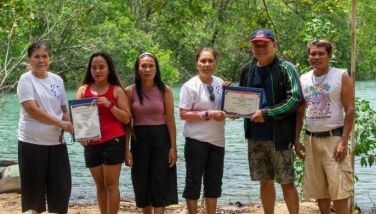The health message on massage
July 13, 2004 | 12:00am
For thousands of years and across many cultures, massage has been part of medical practice. Currently, it is promoted to reduce stress, encourage relaxation, and relieve a range of ailments, from arthritis and asthma to insomnia and sports injuries. Can massage really help with such problems?
Massage (the word comes from the Arabic massa, to stroke) is one of the oldest hands-on therapies. In the East, massage had its beginnings in Chinese medicine, with its patterns of energy "meridians" and pressure points, evolving into acupressure and Japanese shiatsu massage. In the West, massage was first organized for medical treatment in Sweden during the 1800s, becoming a technique that came to be called Swedish massage. It has never really gone out of use, but unfortunately, for many years, medical researchers have not given it rigorous attention.
More recently, however, there had been numerous scientific studies done on the therapeutic effects of massage. In addition, research centers have sprouted devoted to the study of this age-old treatment. One of these centers is the Touch Research Institute of the University of Miami School of Medicine. Studies that have been done in this Institute have found that massage therapy can have a number of surprising benefits. Did you know that massage can:
• Increase immune function in women recently diagnosed with cancer
• Relieve severe premenstrual symptoms
• Lessen labor pains, shorten labor and hospital stays, and reduce the likelihood of postpartum depression
• Heighten alertness; raise speed and accuracy at math calculations
• Reduce migraine headache pain, distress, and sleep disturbances
• Decrease depression, anxiety, stress, pain and insomnia in Chronic Fatigue Syndrome
• Improve mood and sleep
• Lessen itching, pain, and anxiety for burn care patients
• Reduce back pain and job stress?
The three major techniques most often used are deep tissue massage, Swedish massage and Shiatsu.
If you’ve been suffering from chronic backache or muscle pain, a deep tissue massage may help loosen up muscles that are constantly in spasm. According to the American Massage Therapy Association (AMTA), deep tissue massage releases chronic patterns of tension in the body through slow stroking and deep finger pressure. Dr. Nayan Patel, M.D., a physical medicine and rehabilitation specialist at the Texas Back Institute in Plano, usually recommends deep friction massage for patients with low back pain.
"The optimal therapeutic level for deep tissue massage is just below the client’s pain threshold," notes Susan Kaner, a licensed massage therapist in New York. "If you massage too deeply, you can cause the patient more pain, and they are unable to relax."
Depending on the area of concern, deep tissue massage may not require you to undress.
Swedish massage "promotes relaxation, increases circulation and joint mobility, relieves swelling, and speeds up muscle recovery after exercise. By hastening the elimination of metabolic wastes, you’re less sore after a workout, the muscles are better-conditioned, and you’re more able to resume exercise without injury," explains Kaner. A Swedish massage usually lasts 30 minutes to one hour. In most cases, the massage therapist will cover the entire body, unless your doctor requests that the therapy should focus on a particular area. You’ll lie on a massage table with a sheet or towel to cover you (you can keep your underwear on if you like), and the therapist will apply a massage oil to your skin so his/her fingers glide over your skin without any painful friction. There are four basic Swedish massage strokes:
• Effleurage: Gliding strokes using hands or fists to relax soft tissue and encourage lymph drainage.
• Deep friction: Thumb or fingertip pressure, especially where two types of tissues (such as bone and muscle) come together.
• Petrissage: Kneading motions across specific muscles to ease muscular tension.
• Tapotement: Percussive strokes, with the edge of the hand, fingers, or cupped palms to help stimulate local circulation.
Then there is Shiatsu, the Japanese pressure-point massage technique. This is not a gentle massage (this is the one where a masseur or masseuse may walk on your back!). The therapist applies deep pressure points (many of the same meridians where acupuncture needles are placed), and also takes you through a series of twists, stretches and lifts involving various body parts. Unless you’re in a Japanese bathhouse, you’ll be fully clothed and will either lie on a massage table or a padded futon on the floor.
All of these techniques use rhythmically applied manual pressure and movement to help increase blood circulation and the flow of lymph fluid in tissues (lymph carries wastes and impurities away from tissues through a network of specialized glands). Although blood is pumped through the body with each heartbeat, lymph fluid can’t circulate without the squeezing effects of muscle contractions. Stimulation of tissues, especially those that are injured, can help this process.
In addition, massage can help loosen contracted, shortened muscles (those that are in spasm) and can help stimulate muscles that are weak or flaccid, promoting more efficient movement. While massage doesn’t increase muscle strength, it can speed recovery from the fatigue we experience after exercise. Massage also provides gentle stretching for muscles and connective tissue, which helps keep these tissues more elastic. A gentle massage also soothes (or in some cases, stimulates) the nervous system.
Recent research suggests several medical benefits of massage.
• Back pain: A Canadian study on low back pain compared massage therapy with soft-tissue manipulation, exercise, and a sham laser-therapy. Subjects who received massage therapy had less pain and better physical function than those receiving other forms of treatment. Therapeutic massage has also been found to provide better long-lasting relief than acupuncture.
• Pain, nausea, and anxiety: An Australian study showed that a nightly 10-minute foot massage can lessen pain and nausea in hospitalized cancer patients. Research has also found that 30-minute reflexology sessions reduced anxiety in patients hospitalized for breast and lung cancer. Additionally, a randomized study of massage therapy showed that it relieves the symptoms of premenstrual dysphoric disorder (PDD).
• Sleep: In a controlled study done by the University of Arkansas, massage helped critically-ill patients sleep at least one hour longer than the control group.
• Mobility and recovery: At the University of Colorado Health Sciences Center, a study showed that two-thirds of patients attributed their increased mobility, greater energy and faster recovery to the massages they’d received during their stay in the hospital.
• Lymphedema: Breast cancer survivors with lymphedema (swelling due to the buildup of fluid in the arm) often get relief through lymphatic massage, as shown in a study from the Mayo Clinic.
But for those of us who simply have sore muscles in the neck and upper back from sitting at a desk every day, "massage will work on trigger points in those muscles, break them up, and allow muscles to heal," says Dr. Patel.
And while scientists will still have to continue to perform research on the different effects of massage, we who are already enjoying the pleasure it brings can vouch for its ability to release tension and to simply make us feel good!
Massage (the word comes from the Arabic massa, to stroke) is one of the oldest hands-on therapies. In the East, massage had its beginnings in Chinese medicine, with its patterns of energy "meridians" and pressure points, evolving into acupressure and Japanese shiatsu massage. In the West, massage was first organized for medical treatment in Sweden during the 1800s, becoming a technique that came to be called Swedish massage. It has never really gone out of use, but unfortunately, for many years, medical researchers have not given it rigorous attention.
• Increase immune function in women recently diagnosed with cancer
• Relieve severe premenstrual symptoms
• Lessen labor pains, shorten labor and hospital stays, and reduce the likelihood of postpartum depression
• Heighten alertness; raise speed and accuracy at math calculations
• Reduce migraine headache pain, distress, and sleep disturbances
• Decrease depression, anxiety, stress, pain and insomnia in Chronic Fatigue Syndrome
• Improve mood and sleep
• Lessen itching, pain, and anxiety for burn care patients
• Reduce back pain and job stress?
If you’ve been suffering from chronic backache or muscle pain, a deep tissue massage may help loosen up muscles that are constantly in spasm. According to the American Massage Therapy Association (AMTA), deep tissue massage releases chronic patterns of tension in the body through slow stroking and deep finger pressure. Dr. Nayan Patel, M.D., a physical medicine and rehabilitation specialist at the Texas Back Institute in Plano, usually recommends deep friction massage for patients with low back pain.
"The optimal therapeutic level for deep tissue massage is just below the client’s pain threshold," notes Susan Kaner, a licensed massage therapist in New York. "If you massage too deeply, you can cause the patient more pain, and they are unable to relax."
Depending on the area of concern, deep tissue massage may not require you to undress.
Swedish massage "promotes relaxation, increases circulation and joint mobility, relieves swelling, and speeds up muscle recovery after exercise. By hastening the elimination of metabolic wastes, you’re less sore after a workout, the muscles are better-conditioned, and you’re more able to resume exercise without injury," explains Kaner. A Swedish massage usually lasts 30 minutes to one hour. In most cases, the massage therapist will cover the entire body, unless your doctor requests that the therapy should focus on a particular area. You’ll lie on a massage table with a sheet or towel to cover you (you can keep your underwear on if you like), and the therapist will apply a massage oil to your skin so his/her fingers glide over your skin without any painful friction. There are four basic Swedish massage strokes:
• Effleurage: Gliding strokes using hands or fists to relax soft tissue and encourage lymph drainage.
• Deep friction: Thumb or fingertip pressure, especially where two types of tissues (such as bone and muscle) come together.
• Petrissage: Kneading motions across specific muscles to ease muscular tension.
• Tapotement: Percussive strokes, with the edge of the hand, fingers, or cupped palms to help stimulate local circulation.
Then there is Shiatsu, the Japanese pressure-point massage technique. This is not a gentle massage (this is the one where a masseur or masseuse may walk on your back!). The therapist applies deep pressure points (many of the same meridians where acupuncture needles are placed), and also takes you through a series of twists, stretches and lifts involving various body parts. Unless you’re in a Japanese bathhouse, you’ll be fully clothed and will either lie on a massage table or a padded futon on the floor.
In addition, massage can help loosen contracted, shortened muscles (those that are in spasm) and can help stimulate muscles that are weak or flaccid, promoting more efficient movement. While massage doesn’t increase muscle strength, it can speed recovery from the fatigue we experience after exercise. Massage also provides gentle stretching for muscles and connective tissue, which helps keep these tissues more elastic. A gentle massage also soothes (or in some cases, stimulates) the nervous system.
• Back pain: A Canadian study on low back pain compared massage therapy with soft-tissue manipulation, exercise, and a sham laser-therapy. Subjects who received massage therapy had less pain and better physical function than those receiving other forms of treatment. Therapeutic massage has also been found to provide better long-lasting relief than acupuncture.
• Pain, nausea, and anxiety: An Australian study showed that a nightly 10-minute foot massage can lessen pain and nausea in hospitalized cancer patients. Research has also found that 30-minute reflexology sessions reduced anxiety in patients hospitalized for breast and lung cancer. Additionally, a randomized study of massage therapy showed that it relieves the symptoms of premenstrual dysphoric disorder (PDD).
• Sleep: In a controlled study done by the University of Arkansas, massage helped critically-ill patients sleep at least one hour longer than the control group.
• Mobility and recovery: At the University of Colorado Health Sciences Center, a study showed that two-thirds of patients attributed their increased mobility, greater energy and faster recovery to the massages they’d received during their stay in the hospital.
• Lymphedema: Breast cancer survivors with lymphedema (swelling due to the buildup of fluid in the arm) often get relief through lymphatic massage, as shown in a study from the Mayo Clinic.
And while scientists will still have to continue to perform research on the different effects of massage, we who are already enjoying the pleasure it brings can vouch for its ability to release tension and to simply make us feel good!
BrandSpace Articles
<
>



















